US Treasury Suggests Elon Musk Can Export Internet Equipment To Iran

The US Treasury Department has said satellite internet equipment are not under Washington’s sanctions and can be exported to Iran.

The US Treasury Department has said satellite internet equipment are not under Washington’s sanctions and can be exported to Iran.
The Treasury made the comment in reaction to a tweet by SpaceX CEO Elon Musk, suggesting that a license is not needed to provide the firm's Starlink satellite broadband service in the country.
Some people on Twitter had asked Musk to provide the satellite-based internet stations as he did for the people of Ukraine after the Russian invasion. However, most Ukrainians have not been able to access the internet via Starlink because it needs special equipment and is somehow too complicated to set up. Also, the Iranian government would allow any equipment intended for circumventing its internet censorship to enter the country.
The Treasury Department's Office of Foreign Assets Control (OFAC) has a longstanding license that "authorizes certain exports to Iran of hardware, software, and services related to communications over the internet, including certain consumer-grade Internet connectivity services and residential consumer satellite terminals authorized under General License D-1," a department spokesperson said, without specifying whether the license would apply to Musk's plans.
On Monday, Musk said that his company will ask for an exemption from US sanctions to provide Internet access for Iranians as the country is engulfed in widespread protests over the death of a young woman in the custody of hijab enforcement patrols.
Since protests over the death of Mahsa Amini have started, internet connection was significantly slowed down, a strategy the government usually uses during protests to prevent news of unrest reaching the rest of the country and abroad.

Iran’s Supreme Leader Ali Khamenei in a speech to military commanders Wednesday did not mention ongoing protests that can pose a serious challenge to his rule.
Khamenei spoke for the second time in a week despite earlier reports that he had a serious health issue and was under observation by doctors. This time the occasion was the 42nd anniversary of Iraq’s sudden invasion of Iran in September 1980 that led to a bloody and destructive 8-year war.
According to what government-controlled media has reported about his speech, Khamenei solely spoke about the “Sacred Defense” as the Islamic Republic calls the Iran-Iraq war and did not utter even one word abou anti-regime protests that started last Friday.
The trigger for the sudden wave of unprecedented unrest was the killing of a 22-year-old woman who received fatal brain injuries in the custody of the dreaded religious police, apparently for her insufficient hijab. Khamenei also ignored the tragic death that led to the current protests.
Many pundits and politicians had been warning for months about increasing discontent amid both economic hardships and a tightening of Islamic lifestyle limitations particularly on women.
The fact that Khamenei did not mention the protests could be a sign that the regime is baffled by the ferocity of the protests and the apparent lack of fear among the people who confronted police, anti-riot forces and Basij paramilitary agents in the streets on Monday and specially on Tuesday.
People posted many videos on social media showing how crowds overpowered government forces and forced them to retreat. In many instances, when the protesters identified a government agent or caught a policeman off guard, they attacked and assaulted them without fear.
For reasons that are not clear the clerical-military regime has so far not used overwhelming military force against protesters that took over streets in more than 40 cities and town Tuesday evening and well into the night.
In November 2019 when people came out to protest a government decision to suddenly raise gasoline prices, the Revolutionary Guard (IRGC) almost immediately led military, paramilitary and intelligence agents to mercilessly open fire on the people, killing at least 1,500 in in less than a week .
Since then, the regime has become somewhat weaker because of a long-running economic crisis triggered by United States’ sanctions as well as its own corruption and mismanagement. People’s patience and hopes for an improvement have dwindled and the IRGC has also been weakened by signs of an inability to confront foreign infiltrations.
Its feared intelligence organization was reshuffled in June as saboteurs killed several key members of its secret networks, leaving the all-powerful organization publicly embarrassed.
Some also believe that the regime is holding back because President Ebrahim Raisi is currently in New York, attending the UN General Assembly.
It is possible that the regime finds it hard to act decisively in a dangerous situation and perhaps hopes that the protests would eventually die down. It is also possible that it is preparing for a military crackdown, which can start at any moment.
But Khamenei was much more decisive in 2019, when he gave a speech as the killing was taking place and signaled to his forces to show no mercy, accusing protesters of being foreign agents and hoodlums.
Iran’s 83-year-old ruler also did not mention foreign policy or the nuclear negotiations with the US in his Wednesday speech. He has been conspicuously silent about the matter in recent months as his diplomats have engaged in a long series of talks lasting 17 months, as his other entities are expanding Iran’s nuclear program.
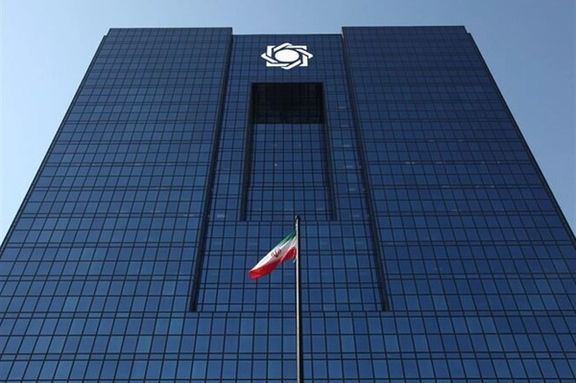
An Iranian hacktivist group says it has started its cyber operations against the Islamic Republic in solidarity with the ongoing protests across Iran over the death of a hijab victim.
On Tuesday and Wednesday some state-owned websites, including the website of the Central Bank of Iran, were targeted by hackers claiming to be from the ‘Anonymous’ hacking group. A member of the group posted a message to the Iranians on Twitter on Tuesday, saying, "We are here with you. The operations against Iran began. wait for us."
At least two main websites of the Iranian government and some state-affiliated media webs as well as the state broadcaster IRIB were among the targets, some of whom were back on line after a few hours. One of the websites of the government hosts “smart services” and another is dedicated to publishing government news and interviews with officials.
“All database has been deleted,” claimed a social media account believed to be affiliated with Anonymous.
A video was also released early on Wednesday showing footage of protests in several Iranian cities that have erupted since Mahsa Amini died in custody of the hijab enforcement patrols. “This was the last straw,” an altered voice on the video said of Amini’s death. “The Iranian people are not alone”.
Following large anti-government protests in Tehran and Amini’s hometown as well as a couple of other cities in the Kurdistan province, demonstrations expanded Tuesday to many Iranian cities and towns, with gunshots reported.
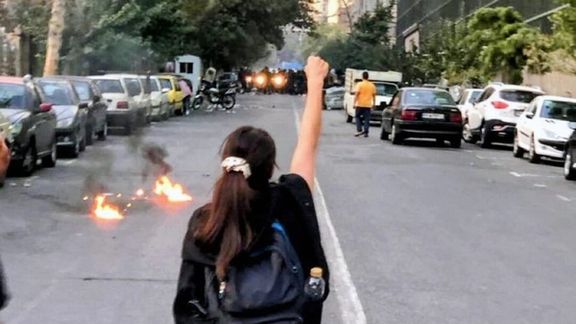
The latest round of nationwide protests in Iran appears to be different from the protests that have rocked the Islamic Republic since 2017 in more than one way.
The protests that started in Tehran late evening on September 16 following the death in custody of Mahsa Amini, 22, was not triggered by financial hardships Iranians have been experiencing in recent years.
Mahsa Amini’s death, a young woman from the Kurdish town of Saqqez, who was reportedly beaten by the hijab patrol agents after her arrest in the street, symbolized pressures the clerical regime exerts on the social freedoms of the young generation, and the regime’s lawless behavior.
The initial gatherings near the hospital where she passed away, were meant to pay respect to an ordinary young woman who was murdered although she had modestly covered her hair and body in the usual black scarf and long manteau many women hate to wear in Tehran's heat even in early autumn. She had not committed a crime or engaged in a major violation of a religious rule.

The crowd, mainly women, gathering around the hospital were angry women many of whom had been earlier forcefully detained and intimidate for their loose headscarves. As an Iranian scholar pointed out earlier this week, the Islamic Republic looks at women's body as a battlefront.
The only thing that has remained of Islam in the Islamic Republic that is overwhelmed by corruption, poverty, unemployment and millions of young men and women with no jobs, no home, no future, is hijab; the arbitrary dress code introduced by hardly educated clerics who have not seen any other country Islamic or otherwise, cannot speak Arabic, which is the language of the holy Koran, have never read a single non-religious book in their lifetime, and can enforce their rule only through coercion.
While the police continued beating protesters and state officials continued telling outrageous lies to explain the young woman's death, the protests spread to the rest of Tehran, particularly its universities, as well as many cities and small towns in various provinces, particularly Iran's culturally rich Kurdistan Province where the young woman came from.
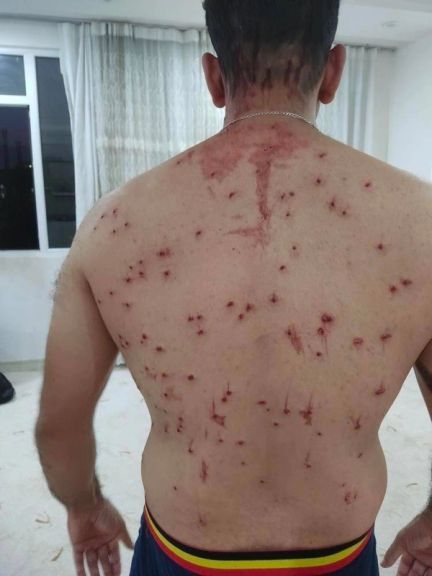
A large part, and at times, most of the protesters are women, although the protests are now less about hijab and more about confronting a dictatorship that has been imposing the clerics' fanatical lifestyle on ordinary Iranians for 43 years. At the same time, many regime officials sent their family members to Europe, the United States and Canada to follow a luxurious lifestyle that has nothing to do with the way of life the clerics impose on the rest of the population.
Many social media users noted that the latest round of protests in Iran is being carried out by the country's embattled middle class. Analysts used to say that protests after 2017 were championed by barefoot hungry men living in the margins of big cities. In the Autumn of 2022, it is more middle-class young men and women who have taken to the streets fearlessly. In many of the videos going viral on social media, fragile young women are seen shouting at policemen with shabby beards and big bellies who brandish their brand new heavy Chinese batons one of which probably shattered Mahsa Amini’s skull.
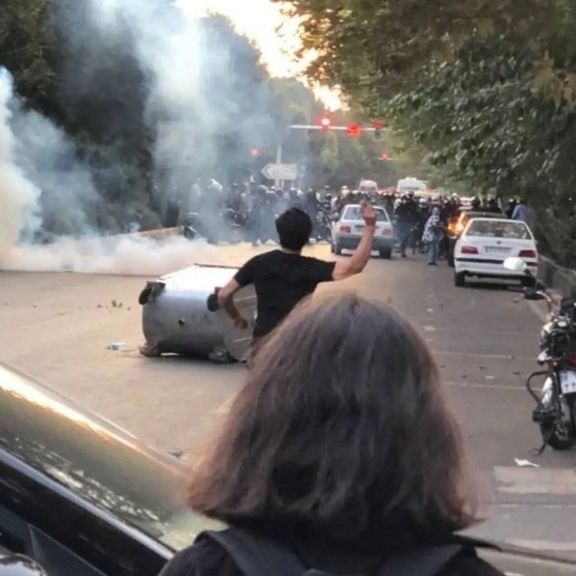
Many of the protesters are born after 2000. They are the generation Z that the Islamic Republic and its clerics have no idea about. The aging officials do not know who they are and what they think. They are the social media generation that the Islamic Republic, its medieval clerical rulers and old-fashioned police force with their outdated weapons can hardly understand. They have their own slang and jargon, and do not care for the "values" the clerics propagate and their untrained militia try to enforce. This is an anachronic dictatorship. Like a cart pulled by donkeys amid a modern expressway. Not only they cannot move forward, but they also disrupt the flow of traffic for those who have the right vehicles for the 21st century.
Iran's Supreme Leader is to meet with his top brass early Wednesday morning. While millions of young middle-class highly educated Iranians that have taken to the streets in recent days are determined to push forward and ignore the barriers, he is likely to persuade his poorly educated, fanatic, obedient militia to shut down the Internet as the "mother of all evil" and use their fire-arms more rigorously to crack down on "rioters, separatists, seditionists and agents of foreign powers," as he and Iran's other hardliners brand those who struggle for civil liberties.
Agent Provocateurs have already paved the way for the crackdown by setting fire to the Islamic Republic flag. A scenario we all know from the 2009 protests to the present day. It's the regime's suppressive might versus the young generation's determination. The winner will be determined in the long run.
In the meantime, ironically, as some social media observers have noted, the police is likely to continue beating people to prove that Mahsa was not beaten to death.
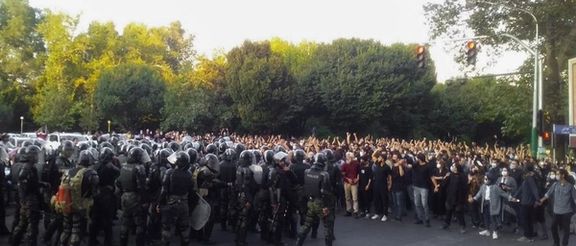
Following Monday’s large anti-government protest in central Tehran, demonstrations expanded Tuesday to many Iranian cities and towns, with gunshots reported.
So far large and small protests have been reported from many large cities and provincial capitals including the religious city of Mashhad, capital of Khorasan-e Razavi Province in northeast; Tabriz capital of East Azarbaijan Province in northwest; Rasht, capital of northern province of Gilan where at least a dozen were arrested in last night’s protests; the religious city of Qom, capital of a province of the same name where most Iranian religious seminaries are located; Ilam, capital of western province of Ilam; Hamedan, capital of a province of the same name; Kermanshah, capital of Kermanshah Province, and Zanjan, capital of Zanjan Province where security forces have clashed with protesters and shot at them.
Later, reports came of protests in Bandar Abbas, a key port city on the Persian Gulf, in Shiraz, capital of Fars Province and in Qazvin.
The protests began Friday when a 22-year-old woman who was arrested a week ago by the Islamic Republic’s hijab police and fatally wounded in custody. She died on Friday, plunging the country into social unrest.
The protests on Monday were reminiscent of large demonstrations in 2009, as thousands of women seemed to be leading the movement, with the critical difference that after 13 years many Iranians have come to reject the clerical system as a whole rather than any particular policy or decision.
Many women took off their headscarves not only in Tehran but even small, traditional towns, to protests the policy of forced hijab. Protesters also chanted slogans against the country’s aging ruler, Ali Khamenei who has increasingly tightened the rule of religious hardliners and his own loyal supporters. He has also resisted reaching an agreement with the United States that would lift sanctions and help the ailing economy.
Although the demonstration at the bazaar has already started, activists have called for more protests in central parts of Tehran at 6:00 pm local time or 9:30 am Washington DC time. In the meantime there is unrest in Tabriz and Mashhad, the second largest city in Iran.
Protests came to an end around midnight in most location, while there no final figures about casualties and arrests. We conclude out live coverage at 20:50 GMT or 16:50 EDT.
----------------------------------------------------------------------------------------------------------------------------
Protests in the capital Tehran generally ended at around 23:00 local time with one eyewitness telling Iran International that he saw the largest concentration of anti-riot and security forces in the city confronting protesters who tried to barricade themselves and pile up objects to throw in self-defense.
---------------------------------------------------------------------------------------------------------------------------
Protesters have burned a vehicle belonging to anti-riot forces is Sabzevar, a city of around 210,000 in eastern Razavi Province.
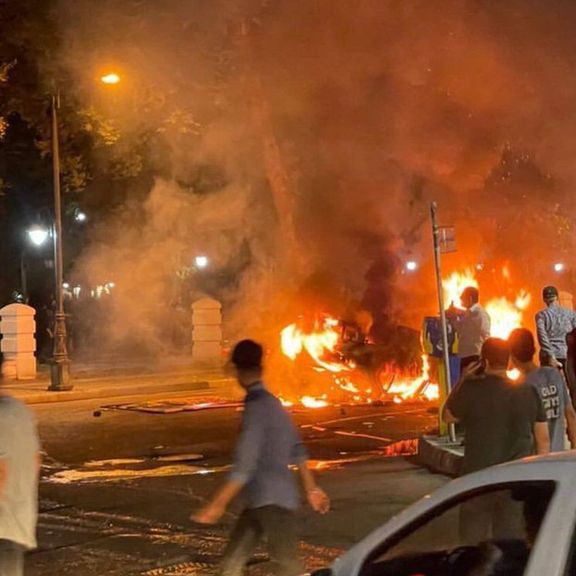
--------------------------------------------------------------------------------------------------------------------------
A 22-year-old protester shot dead by security forces in Orumieh, capital of West Azarbaijan Province has been identified as Farjad Darvishi.

----------------------------------------------------------------------------------------------------------------------------
An hour before midnight in Iran, protesters have remained on the streets in many cities, clashed with security forces who are mostly using tear gas and batons, and burned their vehicles in several places, but there have also been reports of gunfire, although limited in scope. There are no confirmed reports on arrests or possible casualties.
---------------------------------------------------------------------------------------------------------------------------
Protesters have set fire to several vehicles used by security forces in Qazvin, capital of Qazvin Province.
-------------------------------------------------------------------------------------------------------------------------
Tuesday evening - Protesters have taken to the street in Gorgan, capital of the northern province of Golestan, chanting and burning headscarves. One of the videos on social media show security forces attacking protesters.
-----------------------------------------------------------------------------------------------------------------------------
Teusday evening - Protests began in Bandar Abbas, capital of the southern province of Hormozgan, as night fell. Protesters are marching on the streets and chanting.
--------------------------------------------------------------------------------------------------------------------------
Protests have continued in central Tehran where thousands are chanting slogans against the Supreme Leader Ali Khamenei. A video from Palestine Square close to Tehran University shows security forces firing at protesters. The IRGC-linked Fars news agency has reported that security forces have used tear gas to disperse protesters.
-------------------------------------------------------------------------------------------------------------------------
Tuesday Evening - People have taken to the streets and are chanting in Shiraz, capital of the southern Province of Fars. Gunshots are heard in a video posted on Twitter.
--------------------------------------------------------------------------------------------------------------------------
Reports from Iran indicate complete internet shutdown in Kordestan Province where at least four died in anti-government protests Monday, and serious disruptions in mobile internet in several other cities including the capital Tehran, Orumieh, the capital of West Azarbaijan Province, Isfahan, capital of Esfahan Province, and the southwestern Khuzestan Province where extensive protests occurred in May after a massive increase in food prices. “The authorities prevent coverage of protests … RSF demands the restoration of the Internet in Iran!”, Reporters Without Borders tweeted.
----------------------------------------------------------------------------------------------------------------------------
More videos are emerging as evening draws closer which show protesters in other cities such as Kerman, capital of the eastern Kerman Province, are joining the protests.
----------------------------------------------------------------------------------------------------------------------------
Tuesday afternoon - Hundreds have taken to the street in Qazvin, capital of a province of the same name to the west of the capital, chanting “Down with the Dictator” and slogans against clerics. Protesters are booing the police and security forces.
-------------------------------------------------------------------------------------------------------------------------
Tuesday afternoon- Videos from Ilam, capital of a western province of the same name, shows protesters calling Supreme Leader Ali Khamenei “Our Foolish Leader!” and chanting “Death to Khamenei”. There were no protests in Ilam Province Monday.
-------------------------------------------------------------------------------------------------------------------------
Tuesday afternoon - A video from Hamedan, capital of Hamedan Province shows a very large crowd of protesters chanting against the police and shouting “Scoundrels” at them. This is the first time protesters have taken to the street this week in Hamedan, a city of around 800,000.
---------------------------------------------------------------------------------------------------------------------------
Tuesday afternoon - A video posted on Twitter shows a large group of protesters chanting slogans, “Down with the Dictator” at Shariati Square in Mashhad, Iran's second-most populous city. Protests in Mashhad began Monday.
-----------------------------------------------------------------------------------------------------------------------------
A 4-second video shows a group of mainly women chanting “Scoundrels” at police in Zanjan, capital of a province of the same name, for not allowing them to gather while in another video protesters are seen fleeing from security forces who according to social media reports are present in large numbers in some areas of the city.
--------------------------------------------------------------------------------------------------------------------------
Around 18:00 local time - There are some reports of heavy presence of security forces as people gather on the streets of Tabriz, capital of East Azarbaijan Province, where protests have been quite rare in the past few years. Students of Tabriz University have begun protesting, “Students chanted against discrimination and dictatorship. At least one female student in a video posted on Twitter dropped her headscarf at the gathering of students.
Protest in the University of Tabriz
--------------------------------------------------------------------------------------------------------------------------
Late afternoon - Gunshots are heard in Mashhad as anti-riot forces are seen pursuing protesters through a main square.
-------------------------------------------------------------------------------------------------------------------------
Deputy Chief of Gilan province law enforcement, Colonel Hossein Hasanpour, said Tuesday that 22 protesters, who he called ‘rioters’ were arrested Monday night in the provincial capital Rasht.
----------------------------------------------------------------------------------------------------------------------------
----------------------------------------------------------------------------------------------------------------------------
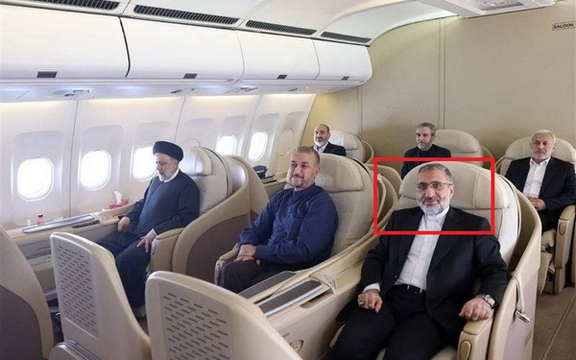
The chief of staff of Iran’s president, who is under sanctions by the European Union like Ebrahim Raisi himself, is accompanying the hardliner president on his trip to New York.
He was first blacklisted in 2011 as Iran’s prisons’ organization chief over “serious human rights violations.”
Gholam-Hossein Esmaili is sanctioned over his "complicity in the massive detention of political protesters and covering up abuses performed in the jailing system."

He was the spokesman of the Judiciary of the Islamic Republic from 2019 until 2021, and served as Tehran Province’s chief justice from April 2014 until August 2019. The former prosecutor was appointed as the head of president’s office on August 8, 2021, the same day Raisi also named Mohammad Mokhber, the chairman of the powerful state-owned foundation sanctioned by the United States.
Raisi – who is himself on US and European sanctions list – is currently in the US along with a large entourage to attend the UN Assembly, despite heavy pressure on the Biden administration to deny a visa for him.
Raisi served as Iran’s Judiciary chief before becoming president in August 2021, but he spent most of life in the Islamic judiciary and is accused by human rights groups of taking part in gross violations of human rights. He was a member of a death committee that ordered the killing of thousands of political prisoners in 1988, an involvement he has proudly admitted.